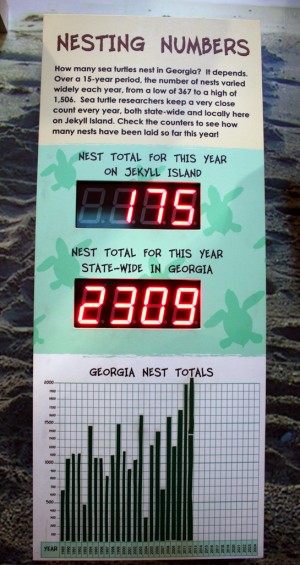Taking a look out back in the Rehabilitation Pavilion at the Georgia Sea Turtle Centre on Jekyll Island is like visiting a hospital made of swimming pools, each one a bed for a special patient. In one pool, a large loggerhead swims about, a metal strip holding together a long gash in its shell made by a propeller.
Sea turtles face many dangers off the East Coast of North America, humans being the most significant. Turtles get caught in fishing gear and are struck by ships. Bright lights, rock walls and heavily populated coastlines keep egg-laying females from the beaches they need to hatch their young. Natural predators and human poachers eat turtle eggs and sometimes the turtles themselves.
Since 2007, the Centre has been the go-to destination for those reporting injured and sick sea turtles. The Centre treats and releases turtles in need of medical care, if they’re expected to survive. In its brief history, the Centre has released about 100 Loggerhead turtles, another 100 Green turtles and about 50 Kemp’s Ridley turtles.
While the Centre works hard at rehabilitation, more significant is the attention it receives for that work – along with the other sea turtle conservation jobs it takes on. The Centre is also mandated to address the underlying causes of sea turtle mortality and population decline through research, public awareness and innovation. For example, Volunteers can sign up with the Centre to join the beach patrol that searches for, monitors and protects sea turtle nests on the string of barrier islands that shield Georgia’s marshy coast.
 Lots of school kids and other groups come through the centre where they learn about the life of the sea turtle and the dangers faced by the various species. Those who peek out back are sure to walk away with a lump in their throats and a new awareness of the impact human activity is having on these long-lived, gentle creatures. The Centre offers summer camps and Scout programs, hosts birthday parties and field trips, guides nest and turtle walks, all in an effort to raise awareness with people of all ages.
Lots of school kids and other groups come through the centre where they learn about the life of the sea turtle and the dangers faced by the various species. Those who peek out back are sure to walk away with a lump in their throats and a new awareness of the impact human activity is having on these long-lived, gentle creatures. The Centre offers summer camps and Scout programs, hosts birthday parties and field trips, guides nest and turtle walks, all in an effort to raise awareness with people of all ages.
The Centre also continues the work of Sinky Howell Boone encouraging fishermen to use a “turtle extruder device” when fishing with nets to avoid catching and drowning sea turtles. In the 1960’s Sinky invented the “Georgia Jumper” to help turtles and other large animals escape his shrimping nets through a hatch in the bottom.
The work of the Centre – and of those assisting turtles before the Centre took up residence at its Jekyll Island location – seems to be making a difference. Sea Turtle nestings along the Georgia coast have been erratic since 1989, but on average climbing with the previous three years being the best. Over 2300 turtle nests – most of them loggerheads – were discovered and protected by the end of 2013 with Jekyll Island alone reaching nearly 200.
Once a private resort for the wealthy, Jekyll Island is now partly a carefully regulated ecological reserve. Beaches on the Atlantic side of the island are shifting naturally with ocean currents, storms and natural erosion, creating a forest graveyard at the northern tip of the island. In spite of the three golf courses that take up far too much of the island centre, Jekyll is well worth a visit for the miles of sand, that eerie dead forest on the beach, the laid back lifestyle and the pedestrian-only heritage district, home to the smart, hard-working and effective Georgia Sea Turtle Centre.
Photo Credits
All photography by Darcy Rhyno – All Rights Reserved





Please Share Your Thoughts - Leave A Comment!